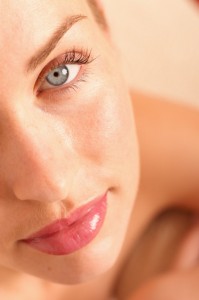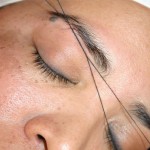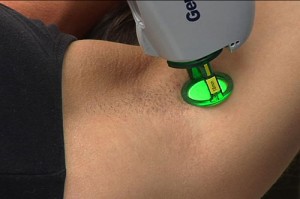Processes of Hair Elimination
0Hair removal is, by nature, an intimate process. Whether it is an eyebrow tweezing, a bikini laser session or perhaps a back wax for a man, hair removal inspires feelings of sensitivity in almost everyone. This is one reason why spas work hard to develop good rapport and relationships with their clients—to develop an atmosphere of trust that will foster the faith that the esthetician will give the client a great service every time.
However, it’s also important to keep up with the latest in hair removal services to provide clients with current offerings from which to choose. “Hair removal is such an intimate thing, clients want to work with someone they feel comfortable with. They want it to be done as quickly and painlessly as possible,” says Heidi Lamar, owner of The Lamar Everyday Spa in Scottsdale, Arizona. “Finding someone you trust and feel comfortable with usually leads to better results.” Of course, for the client, results are ultimately what it is all about.
Hair removal has become a normal part of the beauty regimen for many; not just women, but also men, teens and athletes. Although this expands your client base, it also leads to more customers who want the service done right, every time. “It has just become an extension of what our clients do—a natural part of health and taking care of themselves. This is the best environment for hair removal to be performed, where it’s calm and peaceful and they are familiar with their esthetician and the surroundings. It doesn’t make sense for people to go somewhere else to have hair removal done,” says Lamar.
But to make sure it’s your spa people keep coming back to, you need to not only offer a trustworthy atmosphere, but also high-quality treatments, as well as safety, a large array of options and, perhaps most importantly, the convenience that just isn’t available through home hair removal. “Our hair removal services are quick, effortless and just better than trying to do it on your own, especially since men can’t usually reach their own backs,” jokes Rebecca Dayan, an esthetician with Emerge Spa & Salon in Boston.
Steady waxing
As a standard hair removal treatment, waxing still appears to be a leader in a spa’s arsenal against  unwanted hair. Techniques, supplies, wax types and areas to treat continue to evolve, and smart spa owners are watching for trends on the horizon. “For women, the brow, lip and chin tend to be the most popular, followed pretty closely by the Brazilian. Actually, I think the Brazilian is really becoming more mainstream,” Lamar explains. “Clients find that once they start getting it done, they can’t imagine not doing it. The clean look and feel becomes part of their beauty regimen. Of course, the same is true with facial, underarm and leg waxing, too—clients are loyal to their regimen.”
unwanted hair. Techniques, supplies, wax types and areas to treat continue to evolve, and smart spa owners are watching for trends on the horizon. “For women, the brow, lip and chin tend to be the most popular, followed pretty closely by the Brazilian. Actually, I think the Brazilian is really becoming more mainstream,” Lamar explains. “Clients find that once they start getting it done, they can’t imagine not doing it. The clean look and feel becomes part of their beauty regimen. Of course, the same is true with facial, underarm and leg waxing, too—clients are loyal to their regimen.”
However, there’s a shift going on in those who are seeking waxing treatments. Lip, underarm, bikini and leg waxing are still popular for women, but a growing number of spas are seeing men’s needs move into this market, as well. “We are starting to see more men coming in for waxing services,” says Lamar. “We do primarily chest and back waxes, and sometimes the arms.”
Dayan, who specializes in male hair removal services at Emerge, sees the trend only getting bigger because there seem to be fewer preconceived notions or qualms about male hair removal. “Men do come in and get their backs, shoulders and eyebrows waxed,” says Dayan. “More and more are coming in because it’s getting more fashionable and more normal. We work with a wide range of ages who want to look better. From college-age to grandfathers—there isn’t any set group that’s wanting it, it’s all types. Big, strong guys, professional guys, more metrosexual guys—there aren’t any guidelines. We do see most men for back and shoulder waxes, but then eyebrows second, and neck, chest and ears follow.”
Educating female and male clients about what to expect from waxing is a good way to start treatments, and often, reassurance is necessary. “A lot of men relate waxing to that scene in the movie The 40-Year-Old Virgin, but, for the most part, they are just fine,” says Dayan. “There is definitely a sense of fear that first time and the first pull isn’t very fun, but most men handle it really well.”
Making sure estheticians know a client’s expectations from the outset is important, too. Discussing how much hair should or should not be left, as well as any sculptural grooming, should always be done before the service. Dayan says, “Eyebrow waxing is another popular male waxing treatment, and I always assure clients they won’t end up looking like Joey from the television show Friends. We won’t overly sculpt them—most men just want to be groomed and look professional, so that’s what we offer.”
So although waxing maintains its presence in the hair removal business, spas shouldn’t take advantage of clients’ comfort with it. Continuing to update materials, training, techniques and other wax offerings ensures that you aren’t coasting by on your waxing laurels.
Natural alternatives
Waxing isn’t the only hair removal offering that has clients booking regular appointments at their favorite spas though. Jennifer Pesce, brand director with Shobha, notes more people are seeking other methods of hair removal, and some are looking for a more naturalistic path. “Hair removal is definitely going in two different directions: either all-natural or all high-tech,” Pesce notes, and she leans toward offering the more holistic options: treatments and training for the hair removal techniques of sugaring, threading and tweezing. Although most people are familiar with tweezing, or removing hairs with tweezers, threading and sugaring are just starting to re-emerge legitimate offerings.
 Pesce describes the threading hair removal technique as using a thread that has been twisted like a miniature lasso to loop around the hair and pull it out from the root. “The method we use for eyebrows and other facial hair is threading,” she explains. “Threading and tweezing are good for sensitive skin. You have to be careful with eyebrow waxing because the process can rip off the upper layers of the skin, leaving the client bright pink even several days afterward. Threading has minimal contact with the skin, and I find any signs of irritation go away within an hour.” This less-invasive method makes it preferable for facial hair removal.
Pesce describes the threading hair removal technique as using a thread that has been twisted like a miniature lasso to loop around the hair and pull it out from the root. “The method we use for eyebrows and other facial hair is threading,” she explains. “Threading and tweezing are good for sensitive skin. You have to be careful with eyebrow waxing because the process can rip off the upper layers of the skin, leaving the client bright pink even several days afterward. Threading has minimal contact with the skin, and I find any signs of irritation go away within an hour.” This less-invasive method makes it preferable for facial hair removal.
For other areas where more extensive hair removal is done, Pesce suggests using sugaring, a waxing alternative. “Sugaring is somewhat similar to waxing, but instead of using resin and chemicals, it’s sugar, water, glycerin and lemon juice,” she says. “The mixture sticks to hair, but not the skin, and it’s less irritating, so people really like that.” Sugaring is often done for underarm, leg, chest, back and bikini-area hair removal services, leaving them smooth and hair-free for a period of time, but not permanently. Pesce says, “Waxing and sugaring do take the hair out at the root. It will grow back less in time, but it will still grow back.”
Electric options
If you are looking to go high-tech when getting rid of unwanted hair, you likely have clients interested in the option of permanent hair removal. In the past, electric methods were plagued by the expense and time restrictions involved, including high-priced equipment and training for a spa’s team—not to mention the investment on the clients’ part. Today, a large number of customers are beginning to invest in long-term treatments, such as laser and electrolysis, as hair removal options, making it a much more worthwhile endeavor for spas.
worthwhile endeavor for spas.
“Electrolysis is a permanent method of hair removal, not just a temporary fix,” says Trudy Brown, founder and owner of Advanced Electrolysis and Laser Care Clinic, Inc., which has locations in High Point and Greensboro, North Carolina. “There are three types of electrolysis. The first is thermolysis, where a thin filament or probe inserted into the opening of the hair follicle uses a high-frequency current that basically heats the moisture in the lower portion of the follicle and desiccates it. Then there’s electrolysis by theory, which uses direct current to create a chemical destruction of the follicle; and finally, the method of blend, which is a combination of using the high-frequency current with galvanic heat to create that chemical destruction of the follicle.” As a pioneer in permanent hair removal, electrolysis is often seen as a mainstay in the treatment of unwanted hair.
Much of the recent news in electric hair removal tends to center on laser treatments however, as the method is growing considerably in popularity. One reason for this, according to Louis Silberman, founder of the National Laser Institute, is the cost restrictions are actually a lot less than they used to be. “Laser is more mainstream because it became affordable to the masses,” he says. “Before, machines were costing hundreds of thousands of dollars, so spas had to price treatments outrageously just to pay for the equipment. Now that the machines are more affordable, more people are coming to see laser as a better hair removal option.”
Weighing monthly waxing services versus six months of laser treatments, many are also finding a cost benefit in electric hair removal. “The average consumer is doing their homework now, and they can see that laser hair removal can be cheaper in the long term than waxing,” Silberman says. The upfront time and cost expense is something these clients are willing to forfeit now in order to reap the benefits later.
But to go electric, should you choose electrolysis or laser treatments? Brown says you don’t have to decide, explaining that the methods can work in harmony. “Laser doesn’t treat white, gray or colorless hairs because it responds to the melanin coloring in the hair,” she says. “Electrolysis can treat any color, so using laser to do the larger sections, and then going back and getting the grey or white hairs with electrolysis works well, but electrolysis isn’t as feasible for large areas. It is good for smaller areas, such as the eyebrows, because you do have to go into each follicle one by one. That makes it difficult to do electrolysis on the full legs and back.”
However, some clients still may be skittish at the thought of doing away with hair forever. Silberman recommends weighing the options and helping your client to pick and choose a selection that is right for them. “Trends do change, so some people are nervous that they won’t like not having the hair when that happens,” he says. “But then they can choose what they do want permanently gone—like the underarms or the bikini area.”
Permanent hair removal isn’t only of interest to women, however. “More men are interested in laser hair removal and we recommend them to an area plastic surgeon who offers it,” says Dayan. This, of course, brings up the need for training and professionalism when offering these high-tech services. In many states across the nation, laser use in the spa setting is still unregulated. However, for best results, training is a must. When people start zapping around without knowing what they’re doing, Silberman warns, injuries can happen, and you can quickly turn a loyal client into an angry one. Invest in training before offering these laser and electrolysis services because it will pay off later.
Estheticians who are familiar with their laser treatments and terms also simply offer clients a better result. “Laser hair removal works great on all parts of the body, but different skin types require you to use different lasers,” Silberman explains. “For someone whose skin is dark, if they are African-American or of Middle Eastern decent, you’d probably want to use a 1064 nanometer (nm) laser, where the number represents the wavelength. For someone who is light-skinned, you want to use laser with a different wavelength because it has a different melanin absorption, so maybe a 755 nm or 810 nm laser.”
Keeping it clean
Of course, consulting with your clients before any hair removal treatment is always a must. Waxing, laser, electrolysis, sugaring—almost every hair removal service has contraindications. For example, Lamar says, “Some people are just not good candidates for waxing. Checking someone’s health history for prescriptions or other things that could cause bad reactions is something we always do.”
Having a list of preplanned questions to ask and issues that may arise with hair removal treatments is a good starting point when working with clients seeking removal services. “Treatments are the most consistent and safe with lots of prescreening questions, but you also need to ask the right ones,” explains Silberman. Knowing contraindications, medication issues and health-related problems that could result from a hair removal treatment will help stop problems before they start. For example, both Silberman and Brown point out clients on isotretinoin, often used for acne treatment, should not partake in laser or electrolysis hair removal, and people should also avoid the sun before receiving a treatment.
“It’s very important to focus on training your technicians,” recommends Pesce. “Other than having each technician properly licensed according to your state laws, it’s also good to have a process specific for each waxing service you offer. Some spas are just giving their technicians a vat of wax and saying ‘Go try it.’ Training is a great way to make sure you are offering the same service consistently every time.”
For laser and electrolysis hair removal, initial and continuing training can be of particular importance. “You have to have a knowledge of skin relating to lasers,” says Silberman. “Any esthetic professional offering laser hair removal should understand the physicality and safety of lasers; how the light beam works in the skin and affects the hair shaft before giving treatments. You need to understand the why and what—talk the talk and walk the walk.” With the accumulation of a thorough knowledge of skin, esthetics and hair removal techniques, your team will be more trusted and help you bring in more business.
Even spa owners who aren’t trained in hair removal themselves have options for getting the right instruction for their staff. “You don’t have to be an expert yourself,” says Pesce. “You can outsource your training to people who know what they’re doing and how to teach it.”
A final pre-client prep tip to always remember is to keep your hair removal treatments clean. “It’s really important for hair removal to be a sanitary service,” Pesce says. “Make sure your staff is dedicated to cleanliness for themselves, the equipment, the treatment room, everything.”
Once again, this step is an easy way to avoid potentially complicated problems before they arise, and it makes your spa look respectable, healthy and clean—exactly the message you want to convey.
In the treatment room
Once you’ve had the proper training, asked the right questions and created the ideal conditions for a hair removal treatment, the next step is to prepare the client. This can start as simply as paying attention to the area you’re conducting the service in and the way you offer it.
“We have a dedicated waxing suite, but we also have wax equipment in each treatment room. That way, if the waxing suite is booked, the esthetician can still offer the client a lip or brow wax during their facial,” says Lamar.
Emerge has dedicated an entire floor of its spa solely to men’s services, with Dayan noting that its male clientele enjoys this.“The men are more comfortable in the men’s area. Its more discreet, their own private space where they don’t have to walk through a waiting room full of women in just a towel,” she says.
Next, prepping the client for the procedure should involve making the skin ready for hair removal, and partnering hair removal with other services is a great way to introduce spa methods for getting rid of unwanted hair, showing clients how quick and simple it can be. “In terms of body treatments, you can offer body hair removal especially when you are doing body treatments, such as scrubs. The exfoliation of the scrub sloughs off dead skin and helps to free ingrown hairs for optimal removal,” says Pesce. “With facials or hairstyling, you can suggest eyebrow maintenance to really give a polished, final look. If you do provide hair removal while the client is getting a facial, though, it’s best to do the facial first, and then just tweezing or threading, because deep cleansing afterward could make the area really sensitive.”
Other hair removal post-care tips are to advise the client to stay out of the sun and allow the area to rest for a few days. Pesce says, “I always tell our clients that it takes two to tango, so we’ll be doing our part and they need to be doing their part. For after-care, I basically talk about the big nos: no sun, no sauna, no steam and no sex for bikini treatments for 48 hours after getting the hair removed. The skin is sensitive then, and it’s more susceptible to potential infection. Then, after the first 48 hours, they should be exfoliating on a daily basis and possibly using an ingrown hair relief lotion. But I always tell clients that 48 hours of rest is best.”
Specifically for electric hair removal treatments, Brown also notes, “Post-care, clients should use an antibiotic cream on the area following the treatment, and they need to keep their hands off the area. Also, no microdermabrasion, chemical peels, glycolics or tretinoin should be used on the area.” Giving the skin time to rest and heal is ideal in order to stay safe, so be sure you let clients know they can’t hit the beach immediately.
Finally, once the hair is gone, how long should it stay that way? For treatments such as electrolysis and laser, obviously there will be a longer-term result, but with alternate offerings, such as waxing and tweezing, it’s often the client’s prerogative. “I get the question a lot, ‘How often do I need to come in?’ ” says Dayan. “It’s a personal choice, depending on whether they want the hair to just constantly be gone or not, but usually I see people coming more often, especially during warmer seasons, anywhere from once a month to every two months.”
The growth of hair removal
As an area of spa offerings that continues to earn its keep, hair removal can be an integral part of a business’s menu. “As a spa owner, I encourage other spa owners to understand the significant amount of profit in offering waxing services,” says Lamar. “Take the time to talk with your clients about providing hair removal, because you are doing them a disservice if you don’t take care of what they need. Not to mention that you are losing out on income.”
Ask clients their opinions about your options, as well as other menu items they’d like to see. Brown recommends keeping clients as informed as possible. “I wish spas would better educate clients on all the different hair removal methods,” she says. “They should know about the effectiveness of mixing treatments.” And by combining a trustworthy environment, well-trained estheticians, knowledge about the techniques and products used, ideas about how to pair removal treatments with complementary body and facial services, and a customer-friendly approach, these services can keep your clients coming back for hair removal—as well as the other services on your menu—for years to come.
This article was originally published in the December 2008 issue of Skin Inc. Magazine and is being reprinted with permission. All rights reserved.



